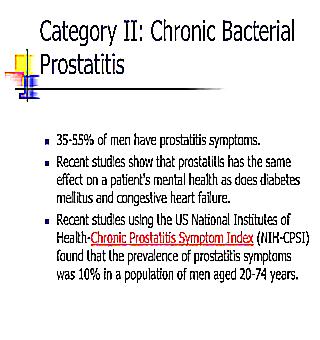Home >
Erectile Dysfunction >
Congestive type of prostatitis definition of etiology and methods of correction
Congestive type of prostatitis definition of etiology and methods of correction

Such a pathology as congestive recurrent prostatitis develops against the background of congestion in the pelvic cavity. The pathogenesis of the development of this condition is based on a violation of the outflow of fluid by the secreted gland, which leads to inflammation in the tissues of the prostate. As a result of a long delay with the secretion in the gland, bacterial infection occurs, followed by the development of an inflammatory reaction.
Etiological factors in the development of congestive prostatitis
It is customary to distinguish between two main reasons for the development of this type of prostatitis as congestive; these include: violation of the outflow of glandular secretions and general changes in the microcirculation of the pelvic organs with a predominance of impaired blood outflow through the venous vessels.
The secreted fluid of the prostate gland is the basis of the seminal fluid, with such a disease, production becomes predominant and, as a result, an inflammatory reaction is formed due to stagnation.
It is customary to refer to provoking factors:
- inadequate output of semen after the end of full intercourse;
- frequent masturbation;
- abstaining from any sexual intercourse for a long time;
- excessively active sex life with frequent appearances promiscuous intercourse;
- a sharp change in the functioning of the main endocrine organs and, as a result, a reduced secretion of testosterone;
- abnormalities in the structure of the prostate.
A disease such as congestive recurrent chronic prostatitis can also manifest itself due to congestion in the pelvic cavity as a result of impaired blood flow.
The predisposing factor for this type of reason I is:
- long sedentary work;
- severely reduced physical activity for a long time;
- intense hyperthermia or hypothermia in the body.
In addition to all of the above provoking factors, the development of the disease, chronic congestive prostatitis can develop as a result of the following reasons:
- inflammatory processes of the urogenital tract, kidneys and the mucous membrane of the bladder cavity;
- physiological age-related changes in the body of an elderly man;
- prolonged constipation and urinary disorders;
- sciatica and other motor processes in the lumbar spine;
- immunodeficiency states and diseases that lead to the basis of the functioning of general and local immunity.
The occurrence of this pathology can be facilitated by all of the above etiological factors, both individually and in combination. All of the above provoking factors are only supposed reasons for the development of the disease, but the true reasons are still unknown.
Typical symptomatic signs in congestive prostatitis
Congestion can progress for a long time in a man's body without provoking the development of specific semantic features. For a very long time, men are unaware of the presence of pathology in their own body, untimely detection of pathology leads to the development of a chronic inflammatory process with subsequent regular recurrence.
Typical symptoms of congestive prostate inflammation include:
- general disorders of the functioning of the urinary system, which is characterized by the manifestation of pain and discomfort during the act of urination;
- at the extreme stage of the disease, enlarged and hypertrophied glandular tissue increases in size and clamps the excretory duct of the urethra, this condition manifests itself as a complete absence of urine outflow with a pronounced and painful urge;
- a gradual decrease in a man's sexual performance;
- a burning and itching sensation going through the entire urethra;
- frequent urge to urinate;
- activation of the central and peripheral nervous system, which is manifested by irritability, a tendency to depression and paralysis of the muscular apparatus of the perineum.
Basic methods of carrying out diagnostic measures
If a man has at least one of the above symptomatic signs, he should immediately seek medical help from a qualified urological specialist. The main task of the doctor is to carry out differential diagnosis of this type of congestive prostatitis with inflammatory diseases of bacterial and oncological etiology. It should be noted that with this type of disease, the inflammatory process is not able to spread to surrounding organs and tissues, unlike other types of prostatitis.
To confirm the main diagnosis, the patient should undergo the following diagnostic measures:
- palpation examination of the glandular organ by rectal access;
- general examination of the patient and questioning the anamnesis of the disease and life;
- determination of the presence of hypersensitivity of the body to the effects of antibacterial drugs;
- conducting general clinical laboratory tests of peripheral blood and urine;
- ultrasound examination of the glandular tissue structure using a rectal probe to obtain a more detailed result;
- in order to exclude the oncological process, patients are recommended to carry out instrumental diagnostics using a computed tomography.
Treatment methods
In the early stages of the disease, a stagnant inflammatory process can be easily treated with conservative therapy. In order to eliminate the inflammatory process, the patient is prescribed antibacterial drugs, most often such groups of drugs as third-generation cephalosporins are used.
Since this disease tends to develop into a chronic process, this leads to a common foundation of the body and a decrease in the function of the immune system. To correct the general condition of patients, drugs of the immunostimulating mechanism of action are prescribed. In order to relieve pain and dysuric disorder, nonsteroidal anti-inflammatory drugs and antispasmodics are prescribed. In addition to drug therapy, physiotherapy is effective.
Depending on the stage at which the conservative treatment of the disease was performed, a prognosis for further recovery is established.



























